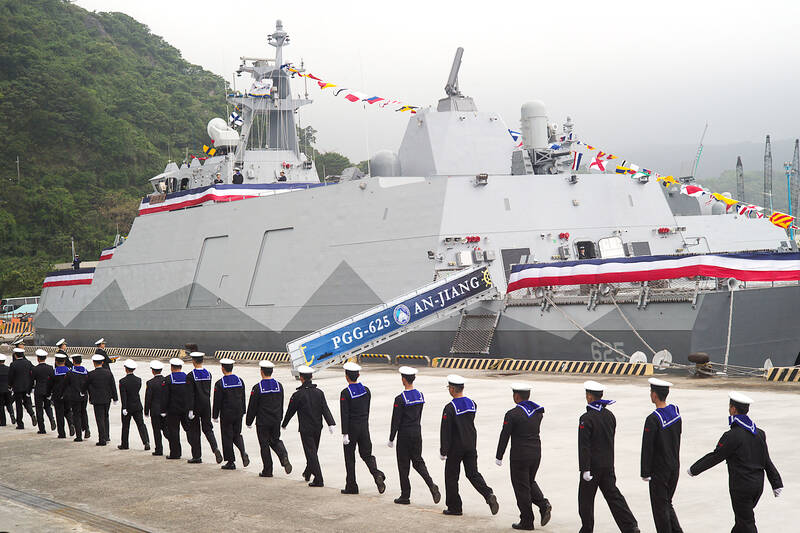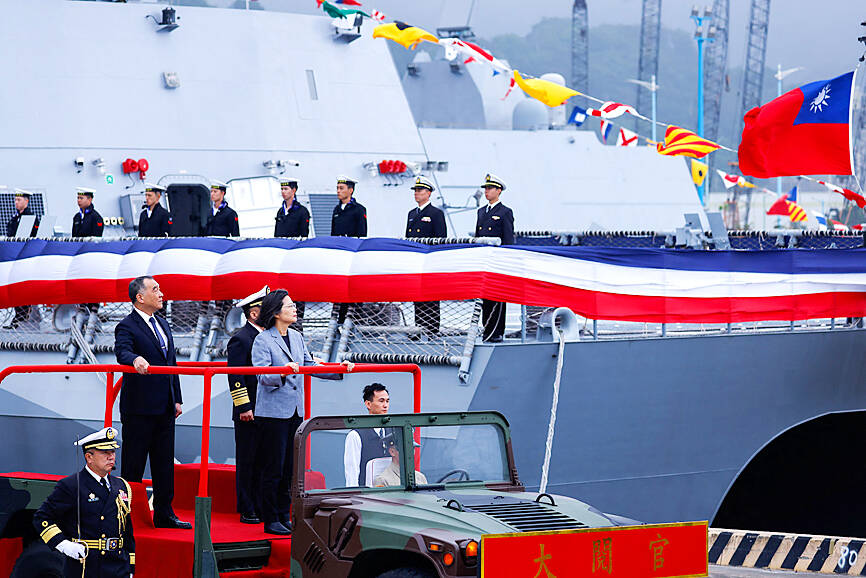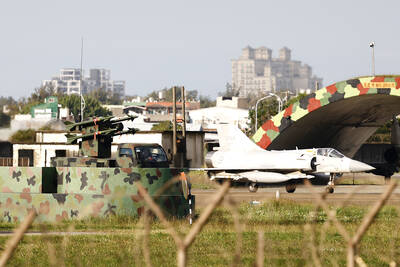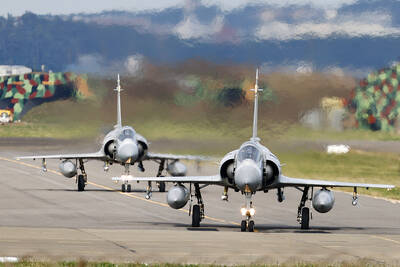President Tsai Ing-wen (蔡英文) yesterday presided over a ceremony at Yilan County’s Suao Harbor (蘇澳港), where the navy took delivery of two indigenous Tuo Chiang-class corvettes.
The corvettes, An Chiang (安江) and Wan Chiang (萬江), along with the introduction of the coast guard’s third and fourth 4,000-tonne cutters earlier this month, are a testament to Taiwan’s shipbuilding capability and signify the nation’s resolve to defend democracy and freedom, Tsai said.
The vessels are also the last two of six Tuo Chiang-class corvettes ordered from Lungteh Shipbuilding Co (龍德造船) by the navy, Tsai said.

Photo: Sam Yeh, AFP
The first Tuo Chiang-class vessel delivered was Ta Chiang (塔江) in 2021, with the vessel’s excellent performance earning international praise after it passed operational tests and evaluations, she said.
The wide recognition motivated the government to speed up corvette production, which allowed for the early delivery of the corvettes yesterday, she said.
The Tuo Chiang-class corvettes have stealth capability, improved stability and are the first small navy ships to be equipped with air defense missiles, she added.

Photo: Ann Wang, Reuters
The vessels also have more powerful performance than the outgoing Chin Chiang-class corvettes which they are to replace, Tsai said.
Su Tzu-yun (蘇紫雲), a research fellow at the Institute for National Defense and Security Research, said the Tuo Chiang-class corvettes, which some media outlets have described as “carrier killers,” are “small, but mighty.”
With a displacement of only 685 tonnes, the highly mobile corvettes can travel at 40 knots, Su said.
Their stealth capability means they have a radar cross-section as small as the size of a fishing boat, he said.
Crucially, they are equipped with layered weapons systems giving them formidable firepower, including TC- 2N air defense missiles, the Hsiung Feng II and Hsiung Feng III anti-ship missiles, and OTO Melara 76mm guns, he said.
The corvettes also have the Phalanx close-in weapons system, which can intercept missiles, as their final line of defense, he added.
The corvettes can be used in combination with land vehicle-mounted missile systems under the planned coastal combat command to guard offshore areas and prevent enemies from attempting landing operations, while submarines are deployed further from shore as a deterrence, thereby forming a multilayered barrier zone, Su said.
The navy plans to acquire five more Tuo Chiang-class corvettes, the contract for which was awarded to Lungteh in March last year.
Also yesterday, Taiwan tested its air defenses in early morning drills using surface-to-air missiles, and air, land and naval forces, saying it would continue to intensify training in the face of China’s frequent military activities nearby.
The Air Force Headquarters in a brief statement said that between 5am and 7am it carried out “overall air defense combat plan exercises” using domestic Sky Bow and US-made Patriot surface-to-air missiles in conjunction with aircraft and navy ships.
The drills were “to inspect and verify the joint air defense combat command and control of the three branches,” it said, adding that the outcome was “good.”
“In the face of Chinese aircraft and ships frequently encroaching into Taiwan’s surrounding sea and air space, the air force will continue to increase its training intensity to deal with potential threats,” the statement said.
Ministry of National Defense spokesman Sun Li-fang (孫立方) said that although there was no direct link between what he called routine annual drills such as these and current tensions, the threat from China is continuing to rise.
“Working out how to bolster our overall military capabilities is very important,” he told reporters.
Additional reporting by Reuters

Taiwan is gearing up to celebrate the New Year at events across the country, headlined by the annual countdown and Taipei 101 fireworks display at midnight. Many of the events are to be livesteamed online. See below for lineups and links: Taipei Taipei’s New Year’s Party 2026 is to begin at 7pm and run until 1am, with the theme “Sailing to the Future.” South Korean girl group KARA is headlining the concert at Taipei City Hall Plaza, with additional performances by Amber An (安心亞), Nick Chou (周湯豪), hip-hop trio Nine One One (玖壹壹), Bii (畢書盡), girl group Genblue (幻藍小熊) and more. The festivities are to

Auckland rang in 2026 with a downtown fireworks display launched from New Zealand’s tallest structure, Sky Tower, making it the first major city to greet the new year at a celebration dampened by rain, while crowds in Taipei braved the elements to watch Taipei 101’s display. South Pacific countries are the first to bid farewell to 2025. Clocks struck midnight in Auckland, with a population of 1.7 million, 18 hours before the famous ball was to drop in New York’s Times Square. The five-minute display involved 3,500 fireworks launched from the 240m Sky Tower. Smaller community events were canceled across New Zealand’s

‘IRRESPONSIBLE’: Beijing’s constant disruption of the ‘status quo’ in the Taiwan Strait has damaged peace, stability and security in the Indo-Pacific region, MOFA said The Presidential Office yesterday condemned China’s launch of another military drill around Taiwan, saying such actions are a “unilateral provocation” that destabilizes regional peace and stability. China should immediately stop the irresponsible and provocative actions, Presidential Office spokeswoman Karen Kuo (郭雅慧) said, after the Chinese People’s Liberation Army (PLA) yesterday announced the start of a new round of joint exercises around Taiwan by the army, navy and air force, which it said were approaching “from different directions.” Code-named “Justice Mission 2025,” the exercises would be conducted in the Taiwan Strait and in areas north, southwest, southeast and east of Taiwan

UNDER WAY: The contract for advanced sensor systems would be fulfilled in Florida, and is expected to be completed by June 2031, the Pentagon said Lockheed Martin has been given a contract involving foreign military sales to Taiwan to meet what Washington calls “an urgent operational need” of Taiwan’s air force, the Pentagon said on Wednesday. The contract has a ceiling value of US$328.5 million, with US$157.3 million in foreign military sales funds obligated at the time of award, the Pentagon said in a statement. “This contract provides for the procurement and delivery of 55 Infrared Search and Track Legion Enhanced Sensor Pods, processors, pod containers and processor containers required to meet the urgent operational need of the Taiwan air force,” it said. The contract’s work would be